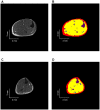Combined MRI and ³¹P-MRS investigations of the ACTA1(H40Y) mouse model of nemaline myopathy show impaired muscle function and altered energy metabolism
- PMID: 23613869
- PMCID: PMC3629063
- DOI: 10.1371/journal.pone.0061517
Combined MRI and ³¹P-MRS investigations of the ACTA1(H40Y) mouse model of nemaline myopathy show impaired muscle function and altered energy metabolism
Abstract
Nemaline myopathy (NM) is the most common disease entity among non-dystrophic skeletal muscle congenital diseases. Mutations in the skeletal muscle α-actin gene (ACTA1) account for ∼25% of all NM cases and are the most frequent cause of severe forms of NM. So far, the mechanisms underlying muscle weakness in NM patients remain unclear. Additionally, recent Magnetic Resonance Imaging (MRI) studies reported a progressive fatty infiltration of skeletal muscle with a specific muscle involvement in patients with ACTA1 mutations. We investigated strictly noninvasively the gastrocnemius muscle function of a mouse model carrying a mutation in the ACTA1 gene (H40Y). Skeletal muscle anatomy (hindlimb muscles and fat volumes) and energy metabolism were studied using MRI and (31)Phosphorus magnetic resonance spectroscopy. Skeletal muscle contractile performance was investigated while applying a force-frequency protocol (from 1-150 Hz) and a fatigue protocol (80 stimuli at 40 Hz). H40Y mice showed a reduction of both absolute (-40%) and specific (-25%) maximal force production as compared to controls. Interestingly, muscle weakness was associated with an improved resistance to fatigue (+40%) and an increased energy cost. On the contrary, the force frequency relationship was not modified in H40Y mice and the extent of fatty infiltration was minor and not different from the WT group. We concluded that the H40Y mouse model does not reproduce human MRI findings but shows a severe muscle weakness which might be related to an alteration of intrinsic muscular properties. The increased energy cost in H40Y mice might be related to either an impaired mitochondrial function or an alteration at the cross-bridges level. Overall, we provided a unique set of anatomic, metabolic and functional biomarkers that might be relevant for monitoring the progression of NM disease but also for assessing the efficacy of potential therapeutic interventions at a preclinical level.
Conflict of interest statement
Figures





Similar articles
-
Multimodal MRI and (31)P-MRS investigations of the ACTA1(Asp286Gly) mouse model of nemaline myopathy provide evidence of impaired in vivo muscle function, altered muscle structure and disturbed energy metabolism.PLoS One. 2013 Aug 20;8(8):e72294. doi: 10.1371/journal.pone.0072294. eCollection 2013. PLoS One. 2013. PMID: 23977274 Free PMC article.
-
ACTA1 H40Y mutant iPSC-derived skeletal myocytes display mitochondrial defects in an in vitro model of nemaline myopathy.Exp Cell Res. 2023 Mar 15;424(2):113507. doi: 10.1016/j.yexcr.2023.113507. Epub 2023 Feb 14. Exp Cell Res. 2023. PMID: 36796746 Free PMC article.
-
Hypertrophy and dietary tyrosine ameliorate the phenotypes of a mouse model of severe nemaline myopathy.Brain. 2011 Dec;134(Pt 12):3516-29. doi: 10.1093/brain/awr274. Epub 2011 Nov 8. Brain. 2011. PMID: 22067542
-
Clinical and Histologic Findings in ACTA1-Related Nemaline Myopathy: Case Series and Review of the Literature.Pediatr Neurol. 2017 Oct;75:11-16. doi: 10.1016/j.pediatrneurol.2017.04.002. Epub 2017 Apr 7. Pediatr Neurol. 2017. PMID: 28780987 Review.
-
Skeletal muscle α-actin diseases (actinopathies): pathology and mechanisms.Acta Neuropathol. 2013 Jan;125(1):19-32. doi: 10.1007/s00401-012-1019-z. Epub 2012 Jul 24. Acta Neuropathol. 2013. PMID: 22825594 Review.
Cited by
-
Multimodal MRI and (31)P-MRS investigations of the ACTA1(Asp286Gly) mouse model of nemaline myopathy provide evidence of impaired in vivo muscle function, altered muscle structure and disturbed energy metabolism.PLoS One. 2013 Aug 20;8(8):e72294. doi: 10.1371/journal.pone.0072294. eCollection 2013. PLoS One. 2013. PMID: 23977274 Free PMC article.
-
Alterations at the cross-bridge level are associated with a paradoxical gain of muscle function in vivo in a mouse model of nemaline myopathy.PLoS One. 2014 Sep 30;9(9):e109066. doi: 10.1371/journal.pone.0109066. eCollection 2014. PLoS One. 2014. PMID: 25268244 Free PMC article.
-
Reduced dietary intake of micronutrients with antioxidant properties negatively impacts muscle health in aged mice.J Cachexia Sarcopenia Muscle. 2018 Feb;9(1):146-159. doi: 10.1002/jcsm.12237. Epub 2017 Oct 16. J Cachexia Sarcopenia Muscle. 2018. PMID: 29045021 Free PMC article.
-
Aberrations in Energetic Metabolism and Stress-Related Pathways Contribute to Pathophysiology in the Neb Conditional Knockout Mouse Model of Nemaline Myopathy.Am J Pathol. 2023 Oct;193(10):1528-1547. doi: 10.1016/j.ajpath.2023.06.009. Epub 2023 Jul 6. Am J Pathol. 2023. PMID: 37422147 Free PMC article.
-
Impaired aerobic capacity and premature fatigue preceding muscle weakness in the skeletal muscle Tfam-knockout mouse model.Dis Model Mech. 2021 Sep 1;14(9):dmm048981. doi: 10.1242/dmm.048981. Epub 2021 Sep 15. Dis Model Mech. 2021. PMID: 34378772 Free PMC article.
References
-
- Schnell C, Kan A, North KN (2000) ‘An artefact gone awry’: identification of the first case of nemaline myopathy by Dr R.D.K. Reye. Neuromuscul Disord. 10: 307–312. - PubMed
-
- Sanoudou D, Beggs AH (2001) Clinical and genetic heterogeneity in nemaline myopathy–a disease of skeletal muscle thin filaments. Trends Mol Med. 7: 362–368. - PubMed
-
- Wallgren-Pettersson C, Sewry CA, Nowak KJ, Laing NG (2011) Nemaline myopathies. Semin Pediatr Neurol. 18: 230–238. - PubMed
Publication types
MeSH terms
Substances
LinkOut - more resources
Full Text Sources
Other Literature Sources
Medical
Molecular Biology Databases

